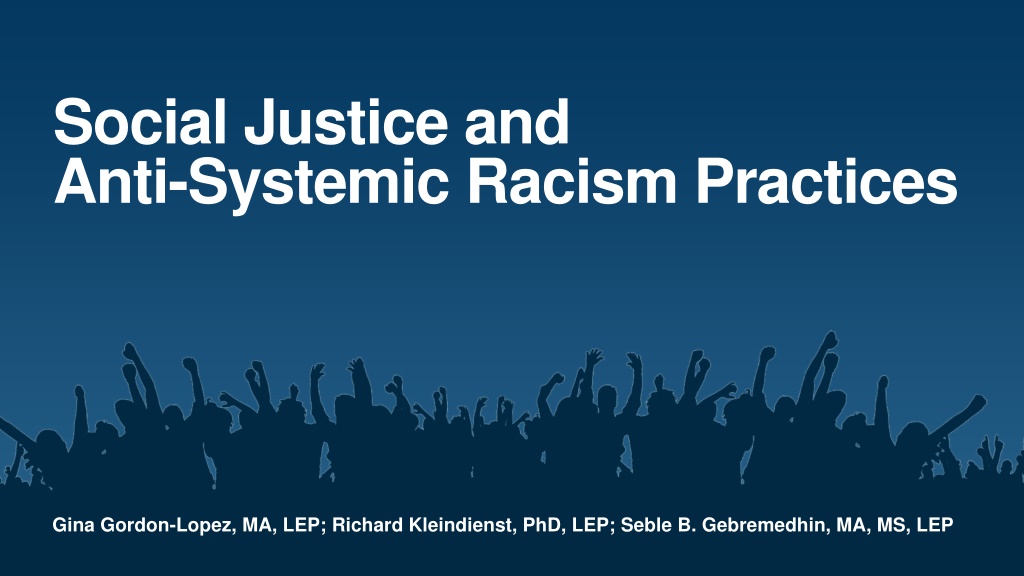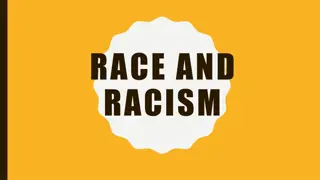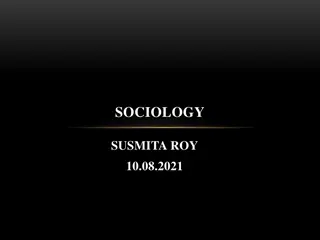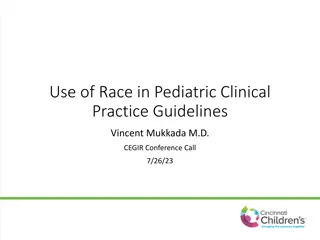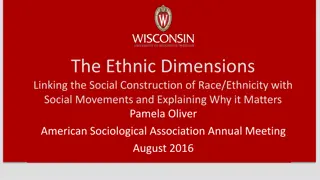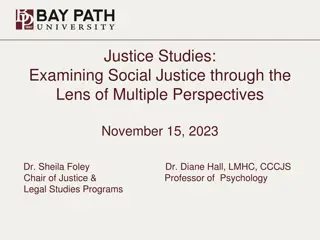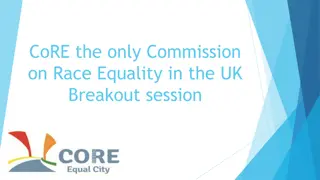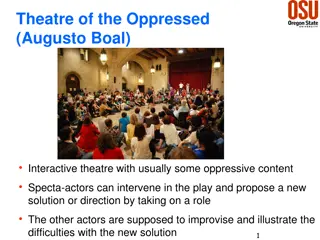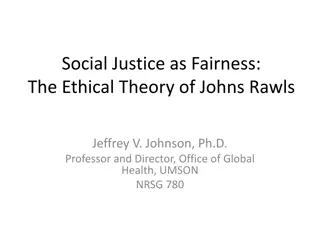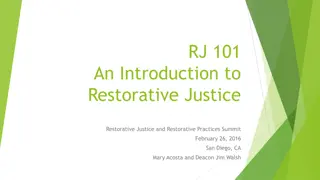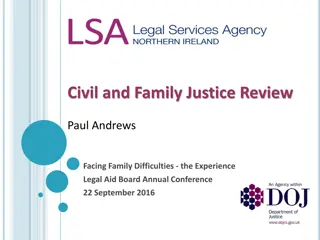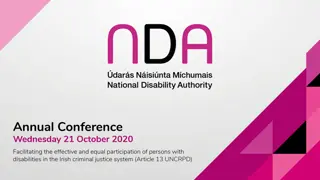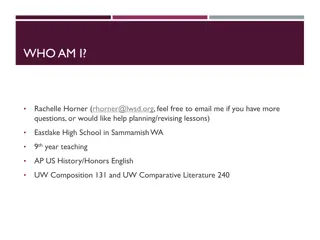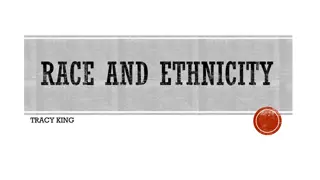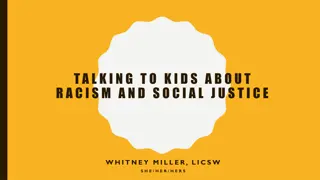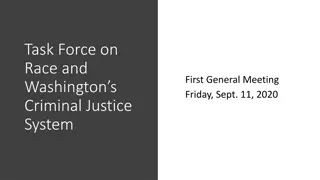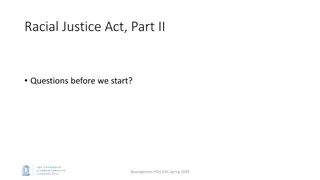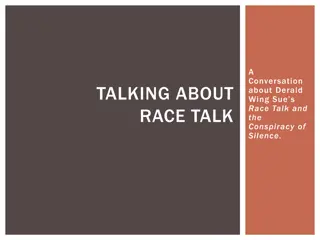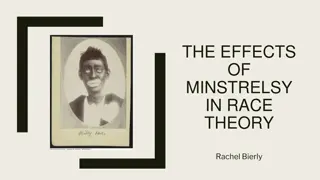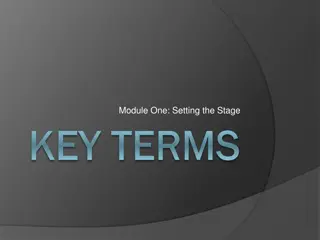Understanding Race: Definitions and Social Justice Implications
Race categorizes individuals based on physical characteristics, affecting social placement. Explore the concept's implications on social justice and anti-systemic racism practices.
Uploaded on Sep 22, 2024 | 0 Views
Download Presentation

Please find below an Image/Link to download the presentation.
The content on the website is provided AS IS for your information and personal use only. It may not be sold, licensed, or shared on other websites without obtaining consent from the author. Download presentation by click this link. If you encounter any issues during the download, it is possible that the publisher has removed the file from their server.
E N D
Presentation Transcript
Social Justice and Anti-Systemic Racism Practices Gina Gordon-Lopez, MA, LEP; Richard Kleindienst, PhD, LEP; Seble B. Gebremedhin, MA, MS, LEP
DEFINITIONS: Race Refers to: The categories into which society places individuals on the basis of physical characteristics (such as skin color, hair type, facial form, and eye shape). Many believe: race is determined by biology It is now widely accepted that this classification system was in fact created for social and political reasons. Presently: There are actually more genetic and biological differences within the racial groups defined by society than between different groups. (Anti-Defamation League (ADL), July 2020)
Definition: Systemic Racism It is believed that systemic racism is: A combination of systems, institutions, and factors that advantage white people and for people of color cause widespread harm and disadvantages in access and opportunity.
Systemic Racism: One person or even one group of people did not create systemic racism, rather it: (1) is grounded in the history of our laws and institutions which were created on a foundation of white supremacy; (2) exists in the institutions and policies that advantage white people and disadvantage people of color; and (3) takes places in interpersonal communication and behavior (e.g. slurs, bullying, offensive language) that maintains and supports systemic inequities and systemic racism. (ADL, July 2020)
Racial and Ethnic Disparities In California it continues to be an area of deep concern across school districts When using the US Department of Education's formula for determining significant disproportionality California s school districts do not fare well. (USDOE regulations for more information)
Rational: Racial and Ethnic Disparities When looking at the percentage of districts that are significantly disproportionate, here is how minority students are disproportionately impacted compared to White students: (CALIFORNIA ASSOCIATION OF SCHOOL PSYCHOLOGISTS POSITION STATEMENT) Specific Learning Disability: Districts that are significantly disproportionate are identifying over 5 times as many Black (11.79%) Latino students (10.74%) Where as White students (2.00%). Intellectual Disability: Districts that are significantly disproportionate Identifying 2 times as many Black students (4.28%) as White students (2%).
Rational: Racial and Ethnic Disparities Total Disciplinary Removals: Districts that are significantly disproportionate in removing students from their educational setting are 20 times more likely to remove a Black student (7.70%) than a White student (0.38%). Poor children and children from minority groups are less likely to be identified as gifted and talented, and more likely to be identified as requiring special education services.
Rational: Racial and Ethnic Disparities Minority students are also more likely to attend schools with a greater police presence, increasing the odds that they will enter the criminal justice system. (Nittle 2020) The school-to-prison pipeline is a product of systemic racism relates to exclusionary discipline and the involvement of law enforcement in response to adolescent behavior. These practices have been characterized by racial disparities and result in the removal of millions of African-American youth from the school system and their channeling into the prison system. (Cousineau 2010)
Rational: Other Group Disparities Those who identify as LGBTQ, have disabilities, and/or are English Language Learners These students are also channeled into the criminal justice system for minor school infractions and disciplinary matters, Are subjected to harsher punishments than their White peers for the same behaviors.
Rational: Racial and Ethnic Disparities Furthermore, The school-to-prison pipeline diminishes their educational opportunities and life trajectories. All educators which includes every school employee are key to ending the school-to prison pipeline. (National Educational Association, 2020) Research shows students amongst certain ethnic groups are disproportionately placed in special education programs (Skiba, R. J., Michael, R. S., Nardo, A. C., & Peterson, R. L. 2002).
Rational: Racial and Ethnic Disparities Such groups have also been: Subject to increased disciplinary measures/actions of suspension, expulsion and/or placement in a more restrictive environment within special education settings (special day programs and non-public schools).
Rational: Racial and Ethnic Disparities The overidentification and further disciplinary actions produce: inequitable opportunities to develop build academic and social skills. Special education has been considered a paradox by some in that While it provides access to additional educational opportunities It can also serve to stigmatize children and Marginalize them from general education (Sullivan, Kozleski, & Smith).
There is ample evidence indicating that groups who are disproportionately represented in special education Are negatively affected by factors such as stigmatization, Lowered expectations, Fewer opportunities to learn, Substandard instruction, and Isolation from the general education environment.(As noted by Sullivan et al. (2009))
As school psychologists, we have an ethical responsibility As school psychologists, we have an ethical responsibility to engage in social justice and anti-racist action. School psychology organizations and graduate education programs play an important role in shaping future generations of school psychologists to lead the mental health, educational and research, and advocacy initiatives that promote equity for the school personnel, students, families, and communities they serve. This is only possible if our field acknowledges, evaluates, and works to reconstruct existing systems, structures, and policies that lead to inequitable outcomes for some groups and not others. (NASP, 2020)
Call To Action for School Psychologists
Ethical Responsibility School psychologists have an ethical responsibility to end systemic racism and to promote anti-racist policies and practices. Work closely with school administrators to: implement and monitor school-based interventions promote alternatives to disciplinary action. monitor students through the Tier 1/Tier 2 PBIS process on a bi-weekly basis. Create targeted goals to address individual needs, outside of the IEP process, to shape a school culture of efficacy and equity to benefit all students. For example, small groups addressing: anger-management, academic progress monitoring, conflict resolution between peers and staff.
Policy Development To participate in policy development that promotes social justice and antiracist policies at the site, district, and professional level. Involvement in school/district committees that address policy development. For example, Disproportionality committees, and Psychologist Peer-Review committees.
Collaboration To collaborate with staff in a unified effort to promote social justice through academic intervention and behavioral support. This can be carried out through the following: Collaboration with teachers, counselors, administrators, and mental health professionals Multi-Tiered System of Supports (MTSS) Positive Behavioral Interventions and Support (PBIS) Functional Behavior Assessment (FBA) Positive Behavior Intervention Plan (PBIP)
Culturally Responsive Practices Practices may include: Understanding one s own identity and values. Knowing how one s own background influences perceptions. Gaining knowledge about the cultural background of others. Developing the skill to enhance practices which result in improved services and an equitable education for all students. Participation in ongoing reflection activities to identify implicit bias and actions that will ensure that students and families are not adversely affected.
Intervention Vigorously and assertively require systematic and quality general education intervention. Practices may include, (Tier 1 & Tier 2) before we agree to an assessment. This includes a systematic review of the exclusionary criteria for SLD before the assessment is initiated to address racial and ethic disparities in special education.
Advocate for Proper Policy Implementation To support students, particularly those with disabilities, to self-advocate for social justice and equity of instruction. To critically evaluate alternative educational placement for disproportionality and initiate corrective actions through partnership with educational leadership.
Increase Cultural Competence To participate in ongoing reflection activities to identify implicit bias and actions that will ensure that students and families are not adversely affected. To participate in professional learning that will increase empathy, knowledge, and skills about diversity of cultures and exclusionary practice.
Utilization of trauma-Informed Practices To use assessment practices that identify underlying trauma that impacts the students academic and social-emotional development. Advocate for trauma-based services to address behavioral issues instead of using exclusionary discipline practices.
Active Roles in Leadership To promote and participate in the recruitment of leadership and teachers that reflect the diverse community they serve. To seek a leadership position that will impact both staff and policies for ending systemic racism and promoting equity for all students.
Preschool to Prison Pipeline Rates of Preschool Expulsions Growing (2016) 19% of preschooler are Black 47% of those suspended are Black Student who are suspended during preschool or elementary school are 10x more likely to be incarcerated
Common Behaviors Problem behaviors at an early age results in long term social and academic difficulties Common Problems with Preschool Student Aggression: hitting, biting, scratching Disruption: yelling, profanity, throwing books and materials, standing on furniture Noncompliance: ignoring adults, refusing to comply, saying no
Typical Preschool Antecedent Interventions Proactive Interventions 1:1 supervision Child led free play activities Frequent choices Multiple set of play materials Predictable schedules Noncontingent praise and encouragement Developmentally appropriate instruction Incidental and errorless teaching
Preschool Life Skills Program (Hanley 2007) Tier 1 or 2 Intervention Balance proactive interventions with gradual and repeated exposure that evokes the problem behavior and teach socially significant behaviors Identify the function Teach replacement behavior (e.g., FCT) Tolerate delays to the functional communication
Features to the Program 1. Controlled exposure to situations that result in problem behavior Giving directions Told to wait Adult diverting attention to others 2. Teaching social skills during these critical situations
Four Units 1. Following Instructions 2. Functional Communication 3. Tolerance 4. Friendship
13 Skills Examples Responding to name being called Complete one step instructions Gain the attention buy saying Use words to gain access to desired materials Wait patiently for adult response Greet/compliment another child Offer toy to another child.
Common Environments Circle time Free choice Mealtime Centers Transition
Teaching Method Behavior Skills Training Whole Group Instruction 1. Teach students during circle time 2. Model skills with another teachers 3. Student practice skills, receiving either descriptive praise or reteaching 4. Opportunities to practice during the day.
Results Most children benefit from the program Classroom social environment improves Benefits of teacher outweigh the effort The students generalize the skill Recommend to other teachers Behavior Analyst provides training and monitors fidelity of implementation
Classroom Management Reducing Discipline Disparities for Black Students GREET-STOP-PROMPT (Cook et al., 2018)
Suspension: Exclusionary Practices Suspensions & Other Exclusionary Discipline Practices Short Term Impact Excluded from learning opportunities Academic Achievement Alienates students from their teachers and peers School Climate Long Term Impact 1/3, 1/6, 1/17
Disproportionality Students of color are the largest proportion of exclusionary practices Black males 2/3x more likely; suspensions and referral of White peers Black students are discipline more harshly with subjective violations Dress Code, Defiance, Disrespect White students are discipline for more objective violations Truancy, Vandalism Results Impairs the trust and bonding with teachers Perpetuates cultural misunderstandings Damages student satisfaction with school
Possible Explanation to Drive Intervention History of Oppression, Economically Disadvantaged? Cultural mismatch; White female teachers and Black students Lack of understanding of Black male student's interaction patterns Misinterpret behaviors to be disrespectful or inappropriate Punitive discipline procedures Implicit Bias; referrals for special education as ED Lack of Teacher skills with classroom management, responding to behaviors Insufficient training to address the issues above, including preservice.
Linking Root Cause to Solutions Proactive Behavioral Support (Prevention) Multicultural Awareness and Competencies Recognition of Implicit Bias Reactive Strategies Targeting interventions to common behaviors Improving relationships between students of color and teachers Responding quickly with consistency and equity (self regulation) Teaching alternative prosocial behaviors
GSP: GREET Proactive Management Strategies Greet at the door High levels of reinforcement, frequently, contingently Establish, review, cue behavioral expectations Engage opportunities to respond Voice high expectations and beliefs in the students.
GSP: STOP Self-Regulation of Staff Stop, don t do anything when you see a behavior Take a break to regulate self Observe knee-jerk reactions about what to do Do what is most effective, positive interventions
GSP: PROMPTS Reactive Strategies Proximity as initial method Redirect tactics to get baseline behaviors Ongoing monitoring of behaviors and social learning/reinforce peers Prompts the student privately with effective commands Teach prosocial behaviors Empathy statements Label inappropriate and appropriate behaviors Give a rationale, Outline choices Logical and natural consequences Think time Check back with the student
Considerations Motivation to change practices Are there resources to support the intervention; training, monitoring? Is there a SW-PBIS, and a culture of support? Is the Approach? Feasible Acceptable Effective
The Reading Gap NAEP* Reading Scores 1992 = 202 Reading Scores 2015 = 215 Criteria Student Groups Advanced > 270 Non SWD 222 Proficient > 240 270 SWD 174 Basic < 240 White 234 Hispanic 207 Black 197 *National Assessment of Educational Progress
Direct Instruction: DI Project Head Start, 1969 1972 Comparing early childhood programs for disadvantage youth Engelmann-Becker Project Follow-Through, 1969 -1993 Follow through on temporary gains in Head Start Largest controlled comparative study of teaching methods 9 models, all showed evidence of effectiveness Engelmann-Becker Model Explicit and Systematic Instruction #1 in reading, math, spelling, and language
DI Theoretical Foundation Assumptions: All students can learn from well designed instruction. When students don t learn there is something wrong with instruction. Students can learn new materials if they have prerequisite skills and instruction is unambiguous. Students make inferences from examples, but they are carefully chosen and designed. Contrary to constructivist and developmental models.
DI Approach Unambiguous instruction Highly structured guidance w/wording, sequencing, & review Track design Placement test Multistage, multiyear Rapid Pace Scripted teaching Ongoing test for mastery
Key Applications Mastery and Placement in the Correct Curriculum Precise examples sequences High-pace questioning Continuous checks for understanding Extended practice drills Rapid error correction, feedback Continuous reinforcement
